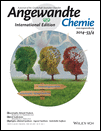Activation of a Photodissociative Ruthenium Complex by Triplet–Triplet Annihilation Upconversion in Liposomes†
This work was supported by the Dutch Organisation for Scientific Research (NWO) by a VIDI grant. Prof. E. Bouwman is kindly acknowledged for scientific discussion and support.
Graphical Abstract
Photoactivated chemotherapy: Liposomes capable of generating blue photons in situ by triplet—triplet annihilation based upconversion of either green or red light, were prepared. The liposomes were used to trigger the photodissociation of ruthenium polypyridyl complexes from ruthenium-functionalized PEGylated liposomes upon excitation with a PDT laser at 630 nm.
Abstract
Liposomes capable of generating photons of blue light in situ by triplet–triplet annihilation upconversion of either green or red light, were prepared. The red-to-blue upconverting liposomes were capable of triggering the photodissociation of ruthenium polypyridyl complexes from PEGylated liposomes using a clinical grade photodynamic therapy laser source (630 nm).





